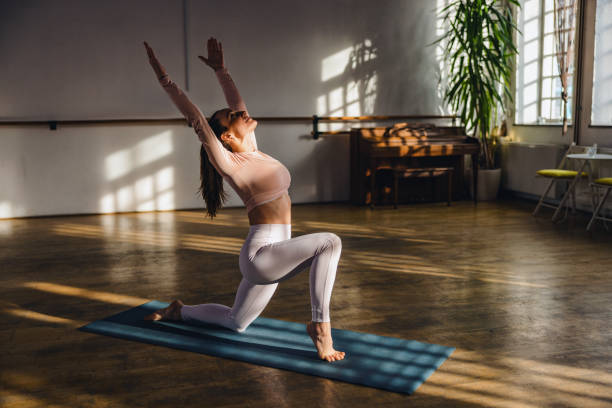In today’s digital age, where many of us spend 8-10 hours a day hunched over a computer or desk, poor posture has become a common issue. The consequences of neglecting your posture can be detrimental, leading to chronic neck and back pain, joint degeneration, and poor blood circulation, among other health problems. However, with the right exercises and habits, you can take proactive steps to correct your posture and improve your overall well-being.
Understanding Proper Posture
Before delving into the exercises that can help you improve your posture, it’s crucial to grasp the fundamentals of maintaining good posture in various situations—standing, sitting, and lying down. Correct posture forms the foundation for a healthy spine and body.
Standing
When you stand, it’s essential to follow these guidelines:
- Foot Placement: Both feet should be flat on the floor, positioned shoulder-distance apart. This stance provides stability and balance.
- Imagine Alignment: Visualize a string gently pulling your head upward towards the ceiling, ensuring that your head is in line with your spine.
- Chin Position: Keep your chin parallel to the floor. Avoid tilting it upward or downward.
- Relaxed Arms: Let your arms hang naturally by your sides, and engage your core muscles by gently pulling your belly button towards your spine.
Sitting
Proper sitting posture contributes significantly to maintaining a healthy spine and reducing the risk of postural problems:
- Back Straight: Sit with your back straight, avoiding slouching or leaning forward. Your shoulders should be pulled back but relaxed.
- Foot Placement: Keep both feet flat on the floor, avoiding crossing your legs. This helps distribute your body weight evenly.
- Chin Alignment: Ensure that your chin is parallel to the floor. This prevents strain on your neck and upper back.
Lying Down
Even during sleep, it’s crucial to support your spine and body:
- Spinal Alignment: Maintain the alignment of your spine while lying down. Avoid twisting at the waist, which can strain your back, shoulders, and neck.
- Sleeping Position: Refrain from sleeping on your stomach, as it can put unnecessary stress on your spine. Instead, lie on your back or side, using a pillow between your legs if you experience back pain.
Exercises for Improving Posture
To combat the negative effects of prolonged sitting and promote better posture, incorporate these exercises into your routine:
Bridges
- Lie on your back with your knees bent and feet flat on the floor.
- Engage your core muscles and lift your hips off the ground.
- Slowly lower your hips back down to the starting position.
- Repeat this motion several times to strengthen your lower back and glutes.
Plank
- Begin on your hands and knees, with your hands aligned beneath your shoulders and your knees under your hips.
- Lift your knees off the ground, straightening your legs to create a straight line from head to heels.
- Keep your chest open, shoulders pulled back, and core engaged.
- Hold this position for at least 20 seconds, gradually increasing the duration as your strength improves.
Hip Flexor Stretch
- Kneel with your right knee on the ground and your left foot in front, bending your knee at a 90-degree angle.
- Keep your back straight, chest forward, and head upright.
- Place both hands on your left thigh.
- Gently press your hips forward, feeling the stretch in your hip flexors, and hold the position for 20 seconds.
- Repeat the stretch on the right side to maintain balance and flexibility.
Mountain Pose
- Stand upright with your feet hip-distance apart.
- Distribute your weight evenly through both feet.
- Maintain a slight bend in your knees, engaging your thigh muscles.
- Relax your shoulders, allowing your arms to hang naturally at your sides.
- Inhale and exhale slowly for a few breaths, focusing on your posture and alignment.
Additional Tips for Maintaining Good Posture
In addition to incorporating these exercises into your routine, consider the following tips to further improve and maintain your posture:
- Regularly Switch Sitting Positions: Avoid staying in one position for too long; shift your posture periodically to prevent stiffness.
- Avoid Crossing Your Legs or Ankles: Crossing your legs or ankles can disrupt your posture and lead to discomfort over time.
- Utilize Support: When sitting at a desk, use a chair with proper lumbar support. Rest your forearms and elbows on a desk or table to keep your shoulders relaxed.
- Rotate Your Whole Body: Instead of twisting at the waist, pivot your entire body to reduce strain on your spine.
- Take Breaks: Stand up and take short walks or stretch breaks throughout the day to relieve tension and promote circulation.
Maintaining good posture is not only essential for preventing pain and discomfort but also for supporting your overall health and well-being. By incorporating these exercises and adopting proper posture habits into your daily routine, you can take significant steps towards achieving and maintaining better posture and a healthier, more comfortable lifestyle.
For additional hip flexor stretch exercises, you can refer to this video tutorial: Hip Flexor Stretch Video Tutorial. This resource offers visual guidance to enhance your stretching routine and further improve your posture.
